Utilization of Micro-Doppler Radar to Classify Gait Patterns of Young and Elderly Adults: An Approach Using a Long Short-Term Memory Network
Abstract
1. Introduction
2. Experimental Work
- Waveform of transmitting wave: Sinusoidal (24 GHz).
- Equivalent isotropically radiated power: 40 mW.
- −3 dB beamwidth in E-plane: 70°.
- −3 dB beamwidth in H-plane: 28°.
- Detection scheme of received signals: Coherent detection.
- Sampling frequency of received signals: 600 Hz.
3. Gait Classification Method
- Calculation of STFT of the received signal (Figure 3 shows an example).
- Extraction of feature envelopes from the STFT spectrogram (, , and in Figure 3 ).
- Inputting the feature envelopes to the LSTM network (Figure 4).
4. Result Evaluation and Discussion
4.1. Accuracy Evaluation and a Comparison between All Input Conditions
4.2. Comparison with the Previous Method Results
4.3. Application of the Convolutional Neural Network-Based Method
5. Conclusions
Author Contributions
Funding
Institutional Review Board Statement
Informed Consent Statement
Data Availability Statement
Conflicts of Interest
Abbreviations
| MDR | Micro-Doppler radar |
| SVM | Surpport vector machine |
| LSTM | Long short-term memory |
References
- Whitney, J.; Close, J.; Lord, S.; Jackson, S. Identification of high risk fallers among older people living in residential care facilities: A simple screen based on easily collectable measures. Archi. Gerontol. Geriatr. 2012, 55, 690–695. [Google Scholar] [CrossRef]
- Hill, K.D.; Logiudice, D.; Lautenschlager, N.T.; Said, C.M. Effectiveness of balance training exercise in people with mild to moderate severity Alzheimer’s disease: Protocol for a randomised trial. BMC Geriatri. 2009, 9, 29. [Google Scholar] [CrossRef] [PubMed]
- Fujimoto, M.; Chou, L. Sagittal plane momentum control during walking in elderly fallers. Gait Posture 2016, 45, 121–126. [Google Scholar] [CrossRef] [PubMed]
- Pradhan, A.; Kuruganti, U.; Chester, V. Biomechanical parameters and clinical assessment scores for identifying elderly fallers based on balance and dynamic tasks. IEEE Access 2020, 8, 193532–193543. [Google Scholar] [CrossRef]
- Begg, R.K.; Palaniswami, M.; Owen, B. Support vector machines for automated gait classification. IEEE Trans. Biomed. Eng. 2005, 52, 828–838. [Google Scholar] [CrossRef] [PubMed]
- Nabila, M.; Mohammed, A.I.; Yousra, B.J. Gait-based human age classification using a silhouette model. IET Biom. 2018, 7, 116–124. [Google Scholar] [CrossRef]
- Gurbuz, S.Z.; Amin, M.G. Radar-based human-motion recognition with deep learning: Promising applications for indoor monitoring. IEEE Signal Process. Mag. 2019, 36, 16–28. [Google Scholar] [CrossRef]
- Ye, W.; Chen, H. Human activity classification based on micro-Doppler signatures by multiscale and multitask Fourier convolutional neural network. IEEE Sens. J. 2020, 20, 5473–5479. [Google Scholar] [CrossRef]
- Cardillo, E.; Caddemi, A. A review on biomedical MIMO radars for vital sign detection and human localization. Electronics 2020, 9, 1497. [Google Scholar] [CrossRef]
- Li, H.; Liang, X.; Shrestha, A.; Liu, Y.; Heidari, H.; Le Kernec, J.; Fioranelli, F. Hierarchical Sensor Fusion for Micro-Gesture Recognition With Pressure Sensor Array and Radar. IEEE J. Electromagn. RF Microw. Med. Biol. 2019, 4, 225–232. [Google Scholar] [CrossRef]
- Orović, I.; Stanković, S.; Amin, M. A new approach for classification of human gait based on time-frequency feature representations. Signal Process. 2011, 91, 1448–1456. [Google Scholar] [CrossRef]
- Senigagliesi, L.; Ciattaglia, G.; De Santis, A.; Gambi, E. People walking classification using automotive radar. Electronics 2020, 9, 588. [Google Scholar] [CrossRef]
- Li, A.; Mehul, J.; Le Kernec, S.; Gurbuz, Z.; Fioranelli, F. Sequential Human Gait Classification With Distributed Radar Sensor Fusion. IEEE Sens. J. 2021, 21, 7590–7603. [Google Scholar] [CrossRef]
- Yang, Y.; Hou, C.; Lang, Y.; Yue, G.; He, Y.Y.; Xiang, W. Person Identification using micro-Doppler signatures of human motions and UWB radar. IEEE Microw. Wirel. Compon. Lett. 2019, 29, 366–368. [Google Scholar] [CrossRef]
- Seifert, A.; Amin, M.G.; Zoubir, M. Toward unobtrusive in-home gait analysis based on radar micro-Doppler signatures. IEEE Trans. Biomed. Eng. 2019, 66, 2629–2640. [Google Scholar] [CrossRef] [PubMed]
- Saho, K.; Sakamoto, T.; Sato, T.; Inoue, K. Accurate and real-time pedestrian classification based on UWB Doppler radar images and their radial velocity features. IEICE Trans. Commun. 2013, E96-B, 2563–2572. [Google Scholar] [CrossRef]
- Okinaka, H.; Saho, K.; Fujimoto, M.; Go, S.; Masugi, M.; Sugano, K.; Uemura, K.; Matsumoto, M. Gait classification of healthy young and elderly adults using micro-Doppler radar remote sensing. In Proceedings of the 2018 Joint 10th International Conference on Soft Computing and Intelligent Systems (SCIS) and 19th International Symposium on Advanced Intelligent Systems (ISIS), Toyama, Japan, 5–8 December 2018; pp. 1222–1226. [Google Scholar]
- Okinaka, H.; Saho, K.; Fujimoto, M.; Go, S.; Sugano, K.; Masugi, M.; Uemura, K.; Matsumoto, M. Gait classification of young and elderly adults using micro-Doppler radar. IEICE Trans. Fundam. Electron. Commun. Comp. Sci. Jap. Ed. 2019, J102-A, 167–170. [Google Scholar]
- Zeng, Z.; Amin, M.G.; Shan, T. Arm motion classification using time-series analysis of the spectrogram frequency envelopes. Remote Sens. 2020, 12, 454. [Google Scholar] [CrossRef]
- Hochreiter, S.; Schmidhuber, J. Long short-term memory. Neural Comp. 1997, 9, 1735–1780. [Google Scholar] [CrossRef] [PubMed]
- Folstein, M.F.; Folstain, S.E.; McHugh, P.R. “Mini-mental state”: A practical method for grading the cognitive state of patients for the clinician. J. Psychiatr. Res. 1975, 12, 189–198. [Google Scholar] [CrossRef]
- Podsiadio, D.; Richardson, S. The Timed “Up & Go”: A test of basic functional mobility for frail elderly persons. J. Am. Geriatri. Soc. 1991, 39, 142–148. [Google Scholar]
- Chen, V.C. The Micro-Doppler Effect in Radar; Artech House: Massachusetts, MA, USA, 2019. [Google Scholar]
- Phinyomark, A.; Thongpanja, S.; Hu, H.; Phukpattaranont, P.; Limsakul, C. The usefulness of mean and median frequencies in electromyography analysis. In Computational Intelligence in Electromyography Analysis: A Perspective on Current Applications and Future Challenges; Naik, G.R., Ed.; IntechOpen: London, UK, 2012; pp. 195–220. [Google Scholar]
- Saho, K.; Sakamoto, T.; Sato, T.; Inoue, K.; Fukuda, T. Pedestrian imaging using UWB Doppler radar interferometry. IEICE Trans. Commun. 2013, 96, 613–623. [Google Scholar] [CrossRef]
- Shrestha, A.; Li, H.; Kernec, J.L.; Fioranelli, F. Continuous human activity classification from FMCW radar with Bi-LSTM networks. IEEE Sens. J. 2020, 20, 13607–13619. [Google Scholar] [CrossRef]
- LaRoche, D.P.; Greenleaf, B.L.; Croce, R.V.; McGaughy, J.A. Interaction of age, cognitive function, and gait performance in 50–80-year-olds. Age 2014, 36, 9693. [Google Scholar] [CrossRef] [PubMed]
- Lau, L.K.; Wee, S.L.; Pang, W.J.B.; Chen, K.K.; Jabbar, K.A.; Yap, P.L.K.; Mallya, J.U.; Ng, D.H.M.; Tan, Q.L.L.; Seah, W.T.; et al. Reference values of gait speed and gait spatiotemporal parameters for a South East Asian population: The Yishun study. Clin. Interv. Aging 2020, 15, 1753. [Google Scholar] [CrossRef] [PubMed]
- Krizhevsky, A.; Sutskever, I.; Hinton, G.E. ImageNet classification with Deep convolutional neural networks. Adv. Neural Inf. Process. Syst. 2012, 25, 1097–1105. [Google Scholar] [CrossRef]
- Selvaraju, R.R.; Cogswell, M.; Das, A.; Vedantam, R.; Parikh, D.; Batra, D. Grad-cam: Visual explanations from deep networks via gradient-based localization. In Proceedings of the 2017 IEEE International Conference on Computer Vision (ICCV), Venice, Italy, 22–29 October 2017; pp. 618–626. [Google Scholar]
- Versaci, M.; Morabito, F.C. Fuzzy time series approach for disruption prediction in Tokamak reactors. IEEE Trans. Magn. 2003, 39, 1503–1506. [Google Scholar] [CrossRef]
- Egrioglu, E.; Bas, E.; Yolcu, U.; Chen, M.Y. Picture fuzzy time series: Defining, modeling and creating a new forecasting method. Eng. Appl. Artif. Intell. 2020, 88, 103367. [Google Scholar] [CrossRef]
- Gao, R.; Duru, O. Parsimonious fuzzy time series modelling. Expert Syst. Appl. 2020, 156, 113447. [Google Scholar] [CrossRef]
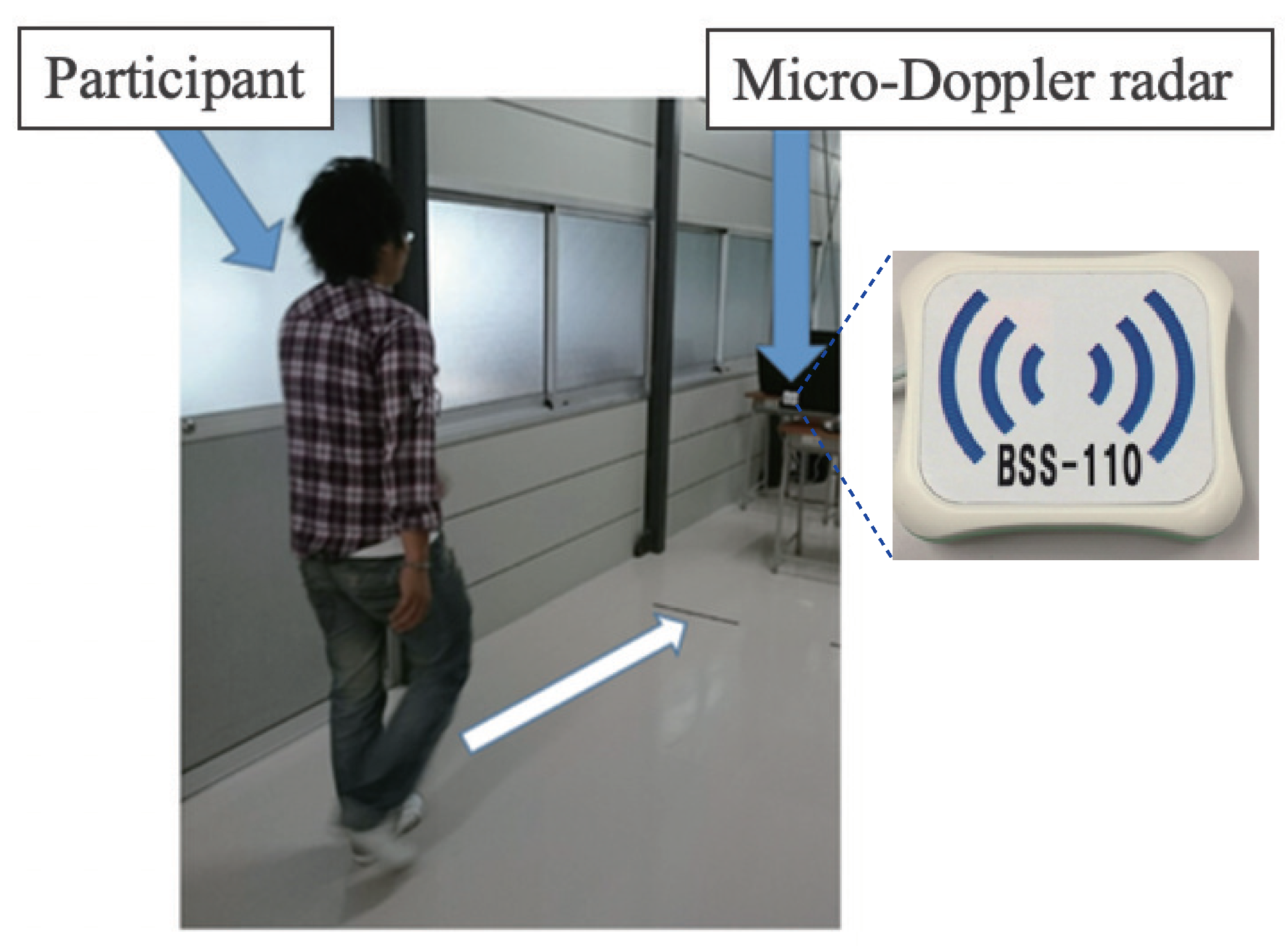
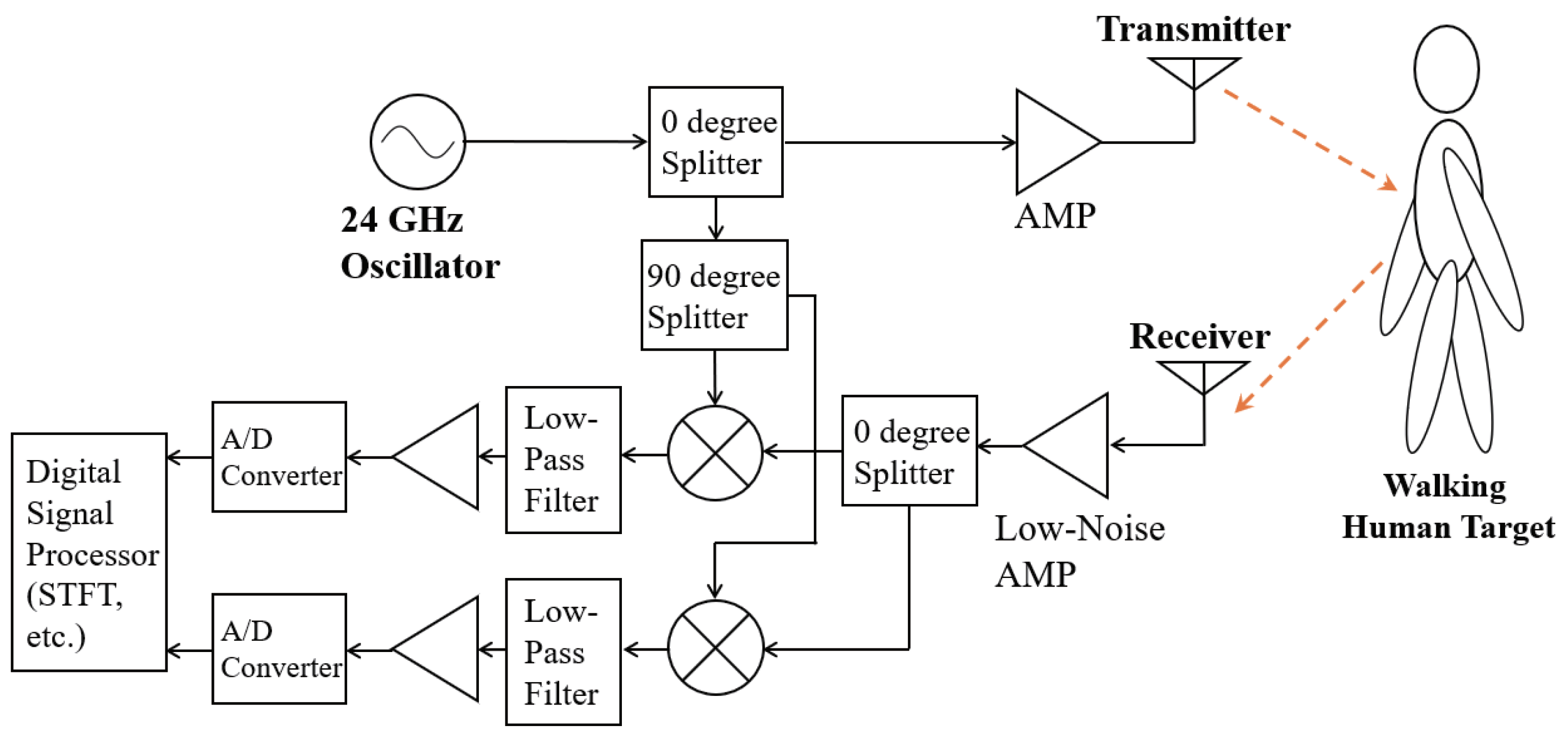

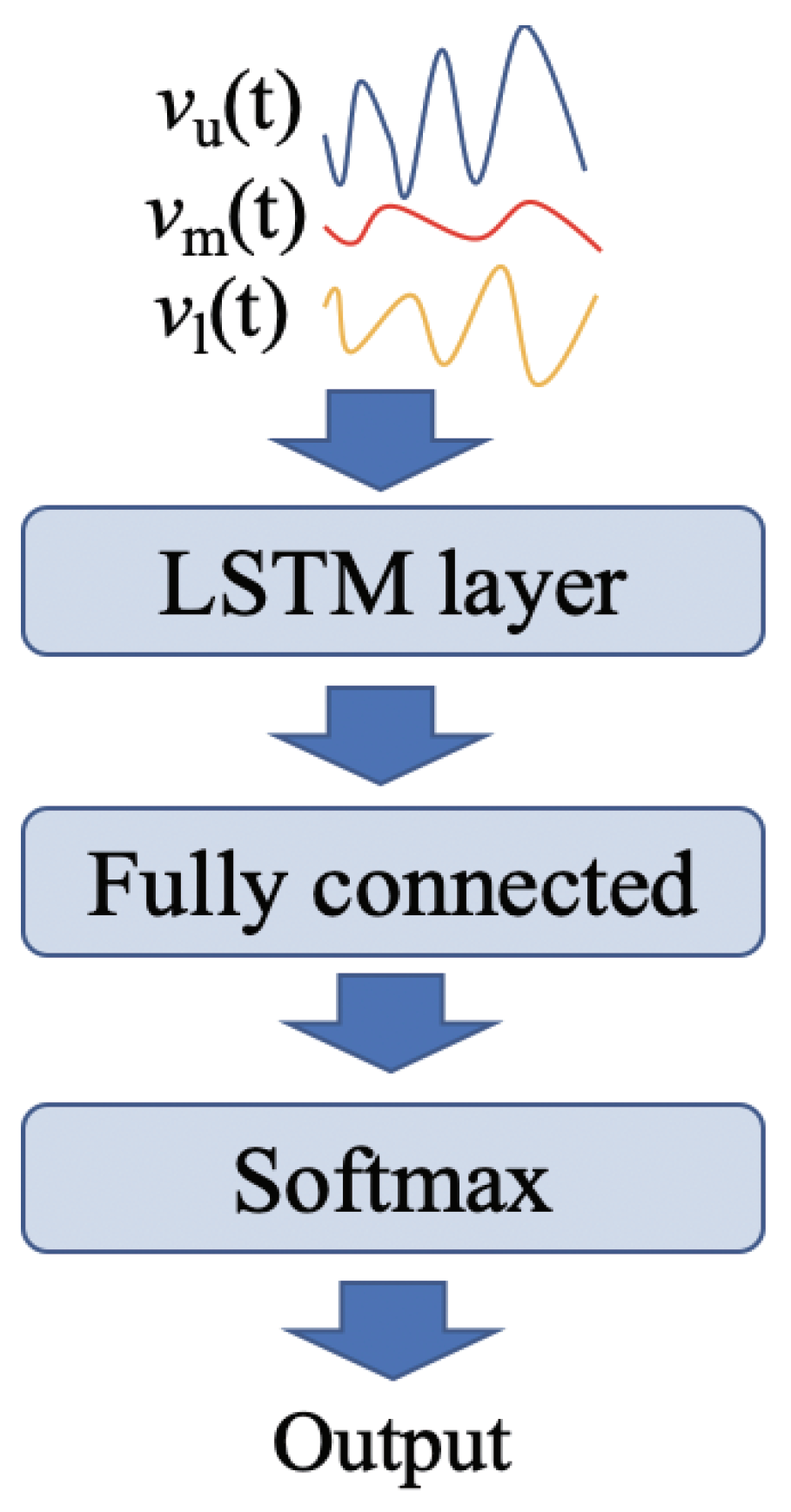
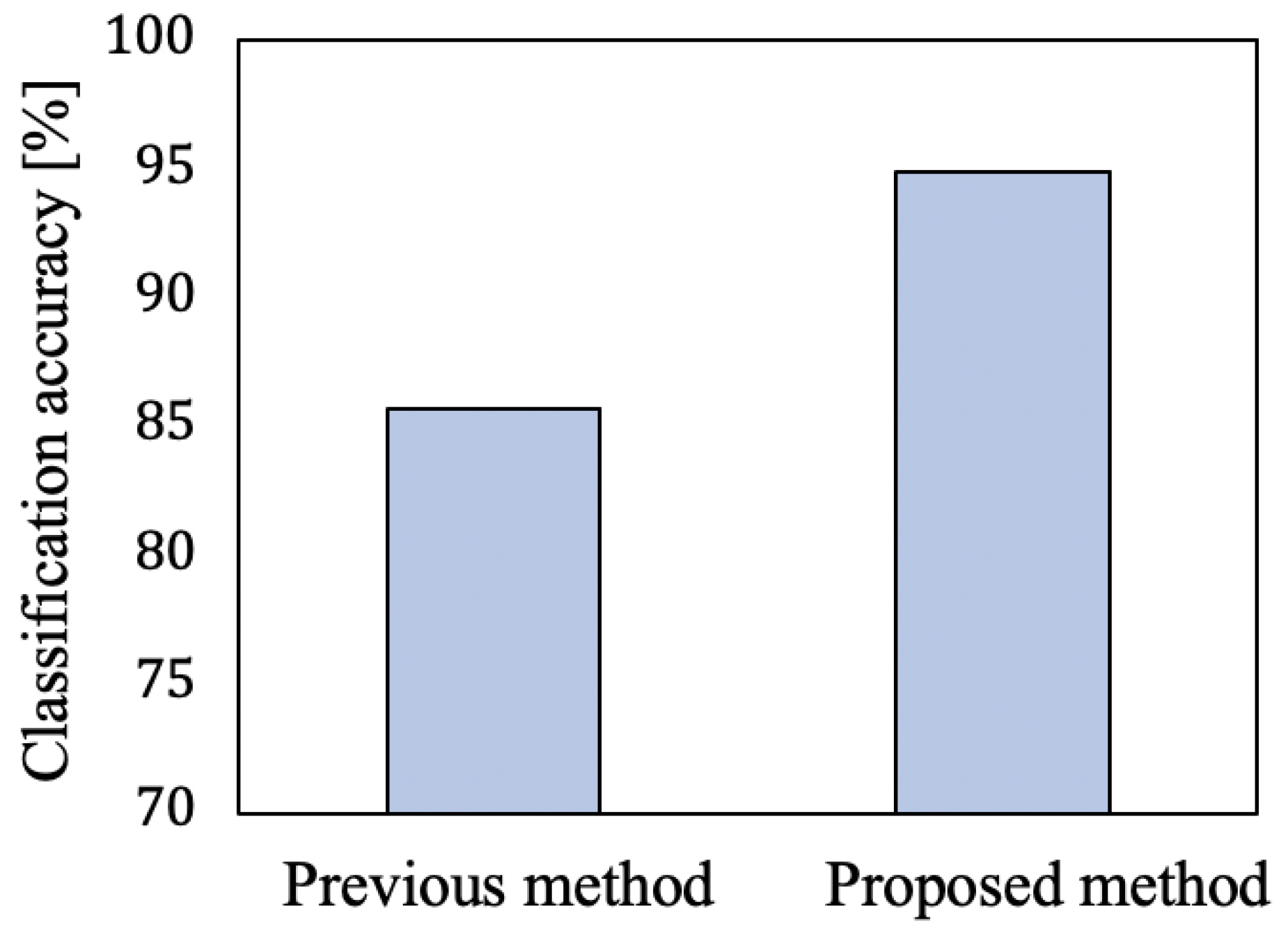
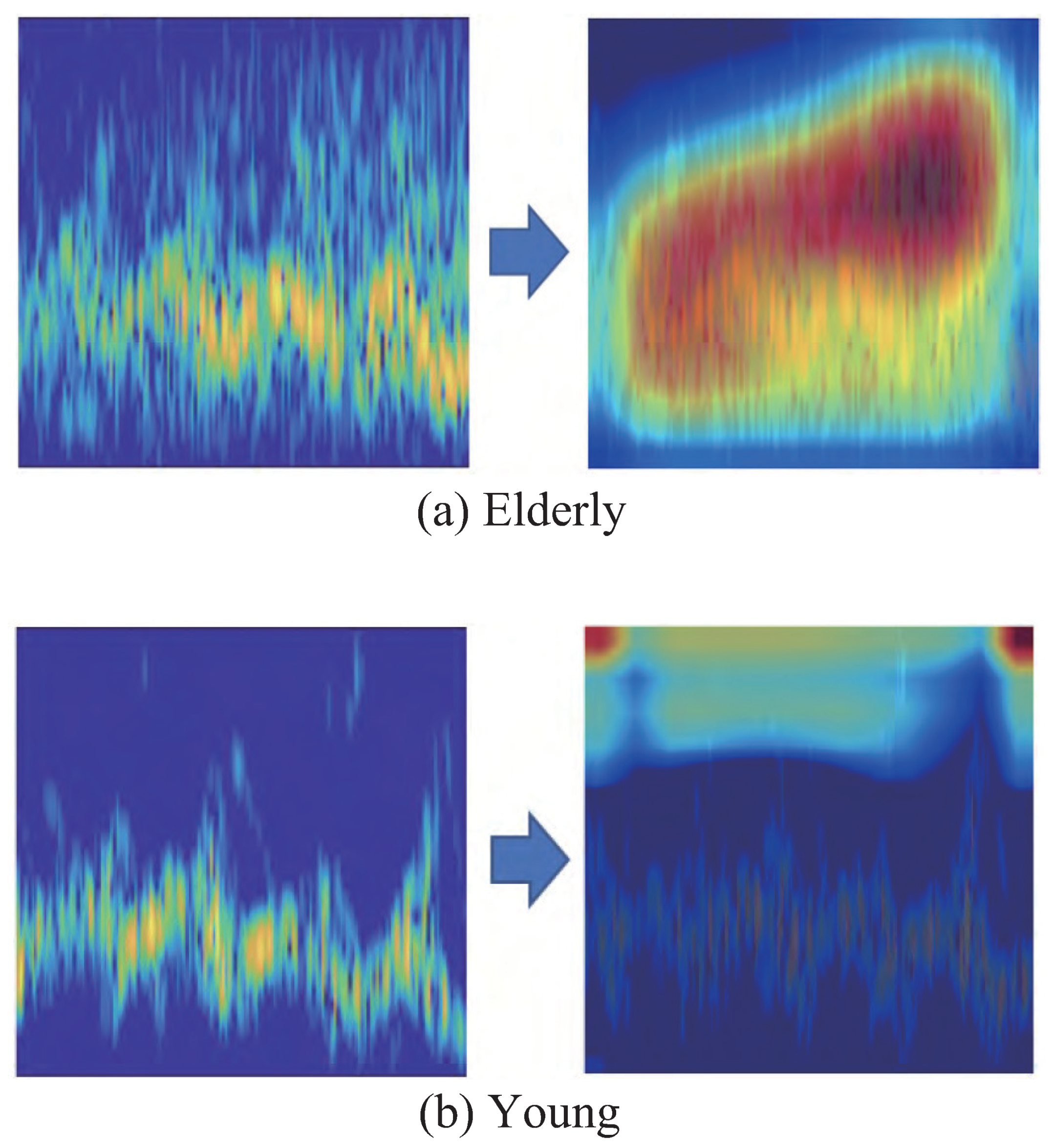
| Condition | Input Velocity Time-Series Data for CNN |
|---|---|
| Condition 1 | |
| Condition 2 | |
| Condition 3 | |
| Condition 4 | , |
| Condition 5 | , |
| Condition 6 | , |
| Condition 7 | , , |
| Condition | Classification Accuracy |
|---|---|
| Condition 1 | 84.9% |
| Condition 2 | 83.3% |
| Condition 3 | 94.9% |
| Condition 4 | 87.0% |
| Condition 5 | 88.6% |
| Condition 6 | 92.0% |
| Condition 7 | 92.7% |
| Predicted Class\True Class | Young | Elderly |
|---|---|---|
| Young | 91.7/84.4/85.1 | 8.3/15.6/14.9 |
| Elderly | 2.2/11.4/4.8 | 97.8/88.6/95.2 |
Publisher’s Note: MDPI stays neutral with regard to jurisdictional claims in published maps and institutional affiliations. |
© 2021 by the authors. Licensee MDPI, Basel, Switzerland. This article is an open access article distributed under the terms and conditions of the Creative Commons Attribution (CC BY) license (https://creativecommons.org/licenses/by/4.0/).
Share and Cite
Hayashi, S.; Saho, K.; Shioiri, K.; Fujimoto, M.; Masugi, M. Utilization of Micro-Doppler Radar to Classify Gait Patterns of Young and Elderly Adults: An Approach Using a Long Short-Term Memory Network. Sensors 2021, 21, 3643. https://doi.org/10.3390/s21113643
Hayashi S, Saho K, Shioiri K, Fujimoto M, Masugi M. Utilization of Micro-Doppler Radar to Classify Gait Patterns of Young and Elderly Adults: An Approach Using a Long Short-Term Memory Network. Sensors. 2021; 21(11):3643. https://doi.org/10.3390/s21113643
Chicago/Turabian StyleHayashi, Sora, Kenshi Saho, Keitaro Shioiri, Masahiro Fujimoto, and Masao Masugi. 2021. "Utilization of Micro-Doppler Radar to Classify Gait Patterns of Young and Elderly Adults: An Approach Using a Long Short-Term Memory Network" Sensors 21, no. 11: 3643. https://doi.org/10.3390/s21113643
APA StyleHayashi, S., Saho, K., Shioiri, K., Fujimoto, M., & Masugi, M. (2021). Utilization of Micro-Doppler Radar to Classify Gait Patterns of Young and Elderly Adults: An Approach Using a Long Short-Term Memory Network. Sensors, 21(11), 3643. https://doi.org/10.3390/s21113643






